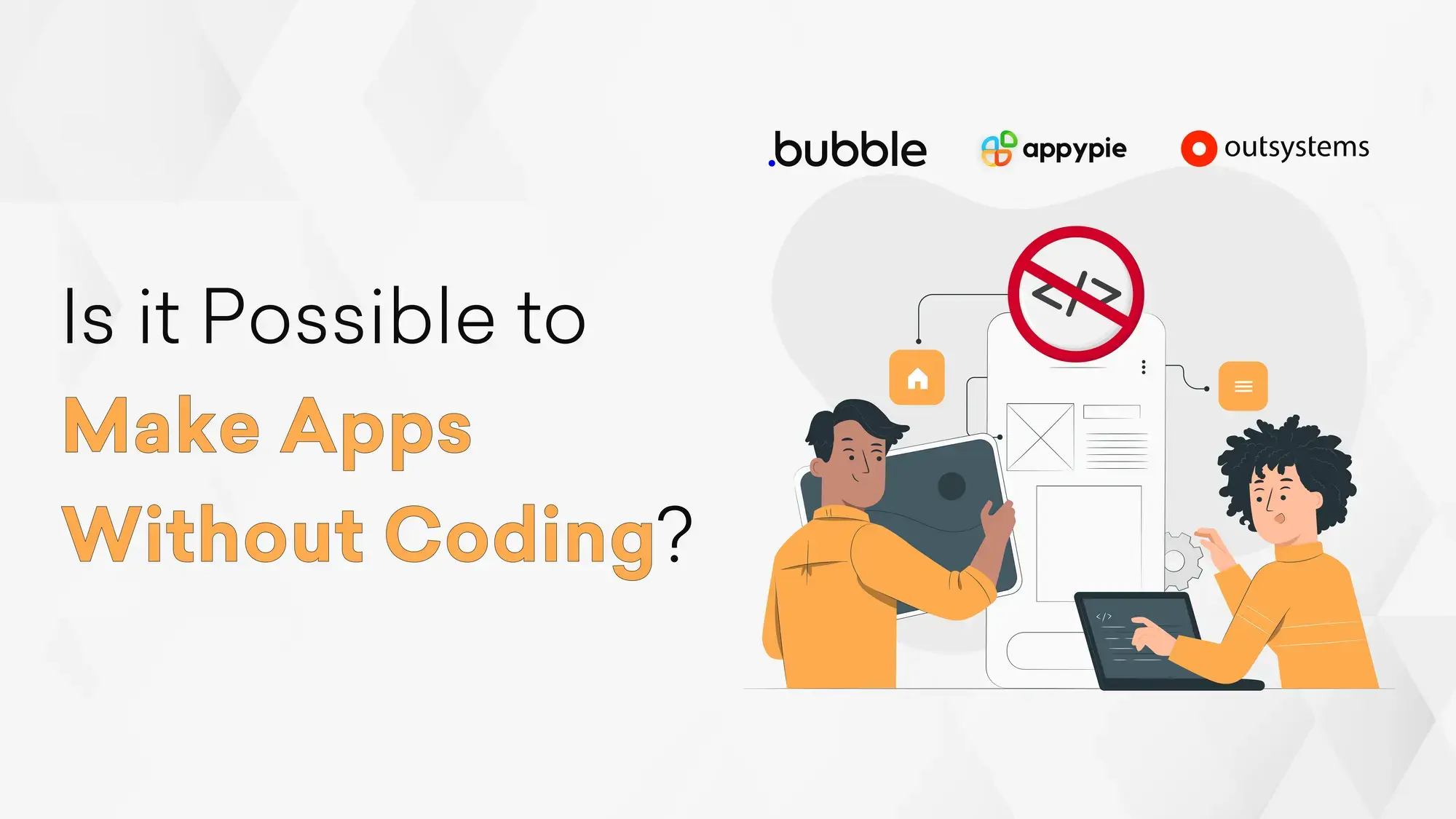Is it Possible to Make Apps Without Coding?

Gone are the days when app development was restricted to a group of code-savvy individuals, laboring over lines of programming languages.
You might be surprised to know that, according to recent studies, low-code and no-code platforms can reduce the time needed to build custom applications by a staggering 50% - 90%.
Let's take a quick flashback to traditional app development. It involved a lengthy process - understanding requirements, drafting designs, coding, testing, and then launching.
However, with the rise of no-code app development tools like Bubble, the narrative is changing dramatically. These tools empower even those without technical expertise to build apps without code and craft their digital masterpieces.
Absolutely! With the emergence of no-code platforms, you can easily bring your app ideas to life without any coding knowledge.
Importance of No-Code Tools in Democratizing App Creation
Let's be real. Not everyone has the luxury of time or resources to learn coding languages. That's where no code app builders come into play.
By bridging the technical gap, these platforms are democratizing app creation. In essence, they're handing over the keys to the kingdom, ensuring that anyone with a brilliant idea can build an app without code.
This is revolutionary. Why? Because it allows more voices, more ideas, and more innovations to enter the app market.
Exploring No-Code App Development Platforms
When it comes to creating apps without coding, there's an array of platforms at your disposal. Each boasts its unique features, targeting specific needs and goals.
Here are some of the best no-code app builders on the market:
Bubble
One of the leaders in the no-code domain, Bubble, provides a user-friendly drag-and-drop environment. With a wide variety of plugins and components, users can tailor their apps down to the finest detail.
Adalo
Adalo makes app creation feel like piecing together a puzzle. This no-code app builder promises and delivers a smooth experience.
With its component marketplace, you can integrate everything from payment systems to chat functions, making it one of the best no-code app builders available.
Appy Pie
Tagged as one of the most versatile no-code app builders, Appy Pie is especially beneficial for those starting their app journey. It comes with a plethora of templates, streamlining the app creation process.
Glide
Ever thought of turning a Google sheet into an app? Sounds wild, right? But with Glide, this crazy idea becomes a reality. It's a shining example of how no-code app development is pushing boundaries and turning unconventional ideas into functional products.
Appsmith
Appsmith is an open-source low-code platform ideal for building internal tools and enhancing low-code development for DevOps workflows. It features Git integration for version control, customizable dashboards for resource visibility, and a drag-and-drop UI builder with JavaScript customization. Appsmith simplifies app creation, integrates with various data sources, and empowers organizations to manage infrastructure efficiently.
OutSystems
Scaling towards the enterprise side of things, OutSystems provides robust solutions for those looking to build apps without code but with all the bells and whistles of traditional app development.
Their visual development environment allows for rapid prototyping and deployment, making them a go-to for many businesses.
If you've been waiting for the right moment to jump into app creation, there's no better time than now. With these no-code app development platforms, the power to create is squarely in your hands.
The No-Code App Development Process
"Can you build an app without code?" – This is a question echoing in the minds of countless innovators and budding entrepreneurs. Well, the answer is an astounding "Yes!"
The rise of no-code app development platforms has given wings to ideas that were once grounded due to coding limitations.
Let's break down the process.
Idea Conceptualization and Wireframing
Before even touching any no-code app builders, start with the basics. Sketch out your idea. Think about the main functionalities your app needs and the problems it aims to solve.
The founders of Airbnb initially had a straightforward concept - allowing homeowners to rent out their space. A simple wireframe on paper (or digital tools like Balsamiq) can help streamline the app's features.
Example: Consider the rise of 'Honeycode', Amazon's entry into the world of no-code app development platforms. Initially, they started with simple templates for everyday tasks.
However, after recognizing the potential and demand for more robust app creation without diving deep into code, they expanded their offerings, allowing users to build apps without code that cater to more sophisticated needs, revolutionizing the way businesses approach internal app development.
Choosing the Right No-Code Tool for the Project
The landscape of no-code application development is vast. Each platform has its strengths. Bubble is excellent for web apps, while Adalo or Glide could be your go-to for mobile apps.
Your wireframe will guide your choice. For a content-centric app, a codeless app builder like Webflow might be ideal.
Designing User Interfaces (UI) and User Experience (UX)
Your app should not only function well but also be aesthetically pleasing and intuitive. Many no-code app development platforms offer drag-and-drop interfaces.
Designing is now as simple as moving elements around. Remember, a clean and uncluttered UI, paired with a smooth UX, can keep users engaged.
Example: Look at Carrd. It's used globally to create app no-code landing pages, which are sleek, single-page sites with impressive UI/UX.
Integrating Functionalities Through Visual Workflows
Here's where the magic happens. With platforms like Bubble or Adalo, you can set actions, define triggers, or create databases – all visually! It’s like piecing together a jigsaw puzzle.
Testing, Debugging, and Refining the App
An app, whether coded or not, needs rigorous testing. Platforms offer previews to simulate user interactions. Gather feedback, find glitches, and refine. Only then can you ensure your app offers a seamless experience.
The world of no-code app builders has democratized app creation, and the horizon looks even more promising. Got an idea? There's probably a platform out there ready to bring it to life.
And if you're looking to get an MVP development out faster using no-code tools, F22 Labs is just the partner you need.
Benefits and Limitations of No-Code App Development
Ever wondered how to build an app without code? It seems impossible, right? But with the rise of no-code platforms, this task is easy for both tech-savvy and non-tech individuals alike.
Let's take a closer look at both the sweet and sour sides of using no-code tools for app development.
Advantages of using no-code tools for app development
1. Rapid development and reduced time-to-market:
One of the most compelling reasons businesses lean towards no-code app development is speed. Traditional app development can take months if not years.
With a no-code app builder, you're looking at weeks or even days. Say goodbye to lengthy development cycles!
2. Accessibility to non-technical individuals:
Ever had a brilliant idea for an app but lacked the technical chops to bring it to life? No code app builders are your genie in a bottle. They democratize app creation, allowing virtually anyone to create an app without coding.
3. Cost-effectiveness and budget-friendly options:
Hiring a team of developers can burn a hole in your pocket. But with the best no-code app builders, you're not just saving time; you're also saving money.
With a variety of budget-friendly options available, even startups and small businesses can enter the app market and create apps without coding.
By utilizing a no-code platform, you can visually design your app, integrate functionalities, and launch it, all without writing a single line of code.
Limitations and scenarios where coding might still be necessary
1. Complex app requirements and customization:
While apps without code cover a broad range of applications, there are scenarios where intricate features demand the precision of traditional coding.
If you're looking to develop the next AAA game or an app with deep machine-learning capabilities, no code might not cut it.
2. Performance and scalability concerns:
Let's face it, as fantastic as they are, not every no-code app builder is optimized for high-performance scenarios.
If your app gains millions of users overnight, will your platform hold? It's crucial to pick the best no-code app builder for your scalability needs.
3. Integration with advanced APIs and third-party services:
While many no-code platforms offer integration with popular services, sometimes you need that unique API or a specialized third-party service. Traditional coding offers a level of flexibility and integration that no-code platforms are still catching up to.
While no-code platforms revolutionize the app development landscape, it's essential to weigh the benefits against the limitations. If you're looking to build an app without code, always consider the end goal and choose the right tool for the job.
And if you ever find yourself in a fix, remember there's always a middle ground: low-code development.
Whether you choose traditional, no-code, or low-code, happy app building!
Empowering Creativity and Innovation Through No-Code Development
We're living in a transformative era where the ability to build apps without code is not just a possibility, but a widespread reality. No code app development is like handing paint and a brush to someone who's never painted and watching them create masterpieces.
Let’s dive into some groundbreaking examples of this.
Tara Reed's "Kollecto" - Art Advisor in Your Pocket
Tara Reed built Kollecto, an art advisory app, without writing a single line of code. By leveraging no-code app builder platforms, Reed turned her passion for art into a platform that recommends personalized art suggestions to users based on their tastes.
It's innovation wrapped in art, with no coding in sight.
Bram Kanstein's "Startup Stash" - A Curated Guide to Resources
Without coding, Bram Kanstein launched Startup Stash, a curated directory of resources and tools to help new startups. It rapidly gained traction and became a hit in the startup community, showcasing that with the right tools, creating apps without coding can lead to massive success.
Ben Tossell's "Makerpad" - No-Code Education for All
Originally started as a side project, Makerpad has grown into a full-fledged educational platform teaching people how to use no-code app development tools. It's a perfect testament to the power of creating apps without traditional coding, while also helping others do the same.
Ryan Hoover’s "Product Hunt" - Discover the Latest in Tech
Yes, the popular platform Product Hunt was initially started without a single line of code. It began as an email list and then utilized various tools to evolve into the powerhouse platform it is today, showcasing daily innovative products and technologies.
Final Thoughts
To quote Steve Jobs, "Everybody in this country should learn how to program a computer... because it teaches you how to think."
But today, with the no-code app development wave, you don't necessarily need to learn programming to build great products. The landscape has evolved, enabling everyone to be creators.
Thinking about building your next big idea without coding? F22 Labs is offering a 1-hour free consultation. Ship your MVP faster using the power of no-code tools.
Don't let code be a barrier to your dreams!
